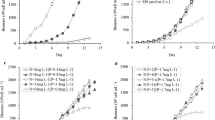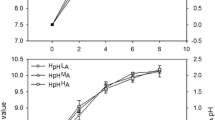Abstract
This study tests the hypothesis that the cellular N:P ratio of the cyanobacterium Microcystis remains at its optimum level if the N:P ratio in the external environmental remains at similar levels. To analyze the relationship between cellular and environmental N:P ratio, Microcystis was cultured in media with varying N:P mass ratios (5, 8.75, 13.3, 25 and 40) for 35 days. In all treatments, the cell density of Microcystis increased throughout the first 15 days and remained stable thereafter. The final N:P mass ratios in the culture medium were 1.0, 3.8, 36, 196 and 437, respectively. The ultimate cellular mass N:P ratios (5.1, 7.1, 11.4, 14.2 and 16.7) were reached and stabilized during the final 15 days. The stable cellular mass N:P ratio equaled the N:P ratio in both the initial and final culture medium if the N:P ratio in the initial culture medium was approximately 7 (mass ratio, known as the Redfield ratio). The Redfield ratio can be explained by the physiology of Microcystis under the culture conditions. The study suggests that cellular N:P ratio is a reliable indicator of nutrient limitation for Microcystis. In addition, the cellular N:P ratio of Microcystis occupying Lake Taihu (China) was investigated. The mass ratio always exceeded 7 during the period from July to November, indicating that Microcystis in Lake Taihu is P limited.







Similar content being viewed by others
Notes
The N:P ratio indicates the mass ratio in the whole study.
References
Allen MM (1968) Simple conditions for growth of unicellular blue–green algae on plates. J Phycol 4:1–4
Bergström AK (2010) The use of TN:TP and DIN:TP ratios as indicators for phytoplankton nutrient limitation in oligotrophic lakes affected by N deposition. Aquat Sci 72:277–281
Calijuri MC, Dos Santos ACA, Jati S (2002) Temporal changes in the phytoplankton community structure in a tropical and eutrophic reservoir (Barra Bonita, S.P.-Brazil). J Plankton Res 24:617–634
Chen Y, Fan C, Teubner K, Dokulil M (2003) Changes of nutrients and phytoplankton chlorophyll-a in a large shallow lake, Taihu, China: an 8-year investigation. Hydrobiologia 506:273–279
de Figueiredo DR, Azeiteiro UM, Esteves SM, Gonçalves FJM, Pereira MJ (2004) Microcystin-producing blooms—a serious global public health issue. Ecotox Environ Safe 59:151–163
Downing JA, McCauley E (1992) The nitrogen: phosphorus relationship in lakes. Limnol Oceanogr 37:936–945
Duan H, Ma R, Xu X, Kong F, Zhang S, Kong W, Hao J, Shang L (2009) Two-decade reconstruction of algal blooms in China’s Lake Taihu. Environ Sci Technol 43:3522–3528
Duong TT, Jähnichen S, Le TPQ, Ho CT, Hoang TK, Nguyen TK, Vu TN, Dang DK (2014) The occurrence of cyanobacteria and microcystins in the Hoan Kiem Lake and the Nui Coc reservoir (North Vietnam). Environ Earth Sci 71:2419–2427
Ebina J, Tsutsui T, Shirai T (1983) Simultaneous determination of total nitrogen and total phosphorus in water using peroxodisulfate oxidation. Water Res 17:1721–1726
Fujimoto N, Sudo R, Sugiura N, Inamori Y (1997) Nutrient-limited growth of Microcystis aeruginosa and Phormidium tenue and competition under various N:P supply ratios and temperatures. Limnol Oceanogr 42:250–256
Geider R, La Roche J (2002) Redfield revisited: variability of C:N:P in marine microalgae and its biochemical basis. Eur J Phycol 37:1–17
Guildford SJ, Hecky RE (2000) Total nitrogen, total phosphorus, and nutrient limitation in lakes and oceans: is there a common relationship? Limnol Oceanogr 45:1213–1223
Hambright KD, Zohary T (2000) Phytoplankton species diversity control through competitive exclusion and physical disturbances. Limnol Oceanogr 45:110–122
Healey FP, Hendzel LL (1979) Indicators of phosphorus and nitrogen deficiency in five algae in culture. J Fish Board Can 36:1364–1369
Hillebrand H, Sommer U (1999) The nutrient stoichiometry of benthic microalgal growth: Redfield proportions are optimal. Limnol Oceanogr 44:440–446
Huang C, Li Y, Yang H, Sun D, Yu Z, Zhang Z, Chen X, Xu L (2014) Detection of algal bloom and factors influencing its formation in Taihu Lake from 2000 to 2011 by MODIS. Environ Earth Sci 71:3705–3714
Kim HS, Hwang SJ, Shin JK, An KG, Yoon CG (2007) Effects of limiting nutrients and N:P ratios on the phytoplankton growth in a shallow hypertrophic reservoir. Hydrobiologia 581:255–267
Klausmeier CA, Litchman E, Levin SA (2004) Phytoplankton growth and stoichiometry under multiple nutrient limitation. Limnol Oceanogr 49:1463–1470
Lambert TW, Holmes CFB, Hrudey SE (1994) Microcystin class of toxins: health effects and safety of drinking water supplies. Environ Rev 2:167–186
Lenton TM, Watson AJ (2000) Redfield revisited: 1. Regulation of nitrate, phosphate, and oxygen in the ocean. Global Biogeochem CY 14:225–248
Li M, Zhu W, Sun Q (2013) Solubilisation of mucilage induces changes in Microcystis colonial morphology. N Z J Mar Freshwater Res 48:38–47
Li M, Zhu W, Dai X, Xiao M, Appiah-Sefah G, Nkrumah PN (2014) Size-dependent growth rate of Microcystis colonies in a shallow, hypertrophic lake: use of RNA/TOC ratio. Aquat Ecol 48:207–217
Lynn SG, Kilham SS, Kreeger DA, Interlandi SJ (2000) Effect of nutrient availability on the biochemical and elemental stoichiometry in the freshwater diatom Stephanodiscus minutulus (bacillariophyceae). J Phycol 36:510–522
Menzel DW, Corwin N (1965) The measurement of total phosphorus in seawater based on the liberation of organically bound fractions by persulfate oxidation. Limnol Oceanogr 10:280–282
Morris DP, Lewis WM (1988) Phytoplankton nutrient limitation in Colorado mountain lakes. Freshwater Biol 20:315–327
O’Neil JM, Davis TW, Burford MA, Gobler CJ (2012) The rise of harmful cyanobacteria blooms: the potential roles of eutrophication and climate change. Harmful Algae 14:313–334
Oh HM, Rhee GY (1991) A comparative study of microalgae isolated from flooded rice paddies: light-limited growth, C fixation, growth efficiency and relative N and P requirement. J Appl Phycol 3:211–220
Olsen Y (1989) Evaluation of competitive ability of staurastrum luetkemuellerii (chlorophyceae) and Microcystis agruginosa (cyanophyceae) under P limitation. J Phycol 25:486–499
Ozawa K, Fujioka H, Muranaka M, Yokoyama A, Katagami Y, Homma T, Ishikawa K, Tsujimura S, Kumagai M, Watanabe MF (2005) Spatial distribution and temporal variation of Microcystis species composition and microcystin concentration in Lake Biwa. Environ Toxicol 20:270–276
Paerl HW, Otten TG (2013) Harmful cyanobacterial blooms: causes, consequences, and controls. Microbial Ecol 65:995–1010
Pick FR, Lean DRS (1987) The role of macronutrients (C, N, P) in controlling cyanobacterial dominance in temperate lakes. N Z J Mar Freshwater Res 21:425–434
Redfield AC (1958) The biological control of chemical factors in the environment. Am Sci 46:205–221
Rhee GY, Gotham IJ (1980) Optimun N:P ratios and coexistence of planktonic algae. J Phycol 16:486–489
Sterner R, Elser J, Hessen D (1992) Stoichiometric relationships among producers, consumers and nutrient cycling in pelagic ecosystems. Biogeochemistry 17:49–67
Tett P, Droop MR, Heaney SI (1985) The Redfield ratio and phytoplankton growth rate. J Mar Biol Assoc UK 65:487–504
Tezuka Y (1989) The C:N:P ratio of Microcystis and Anabaena (blue-green algae) and its importance for nutrient regeneration by aerobic decomposition. Jpn J Limnol 50:149–155
Tsukada H, Tsujimura S, Nakahara H (2006) Effect of nutrient availability on the C, N, and P elemental ratios in the cyanobacterium Microcystis aeruginosa. Limnology 7:185–192
Xie L, Xie P, Li S, Tang H, Liu H (2003) The low TN:TP ratio, a cause or a result of Microcystis blooms? Water Res 37:2073–2080
Xu H, Paerl HW, Qin B, Zhu G, Gao G (2010) Nitrogen and phosphorus inputs control phytoplankton growth in eutrophic Lake Taihu, China. Limnol Oceanogr 55:420–432
Xu H, Qin B, Zhu G (2012) Nutrient limitation of cyanobacterial growth in different regions of Lake Taihu in summer. China Environ Sci 32:2230–2236 (in Chinese with English abstract)
Xu H, Zhu G, Qin B, Paerl HW (2013) Growth response of Microcystis spp. to iron enrichment in different regions of Lake Taihu China. Hydrobiologia 700:187–202
Yi W, Wang G, Liu X, Ma Z (2005) Effects of N/P ratios on the growth and some biochemical constituents of Microcystis aeruginosa. J Northwest Sci-Tech Univ Agric For 33:151–154 (In Chinese with English Abstract)
Acknowledgments
This study was sponsored by the Program on Furtherance of Scientific Research of Japan, Fundament C (15K00630), the National Natural Science Foundation of China (Grant 51409216) and National Program on Key Basic Research Project of China (2012CB719804).
Author information
Authors and Affiliations
Corresponding author
Ethics declarations
Conflict of interest
None.
Rights and permissions
About this article
Cite this article
Zhu, W., Sun, Q., Chen, F. et al. Cellular N:P ratio of Microcystis as an indicator of nutrient limitation—implications and applications. Environ Earth Sci 74, 4023–4030 (2015). https://doi.org/10.1007/s12665-015-4707-x
Received:
Accepted:
Published:
Issue Date:
DOI: https://doi.org/10.1007/s12665-015-4707-x




